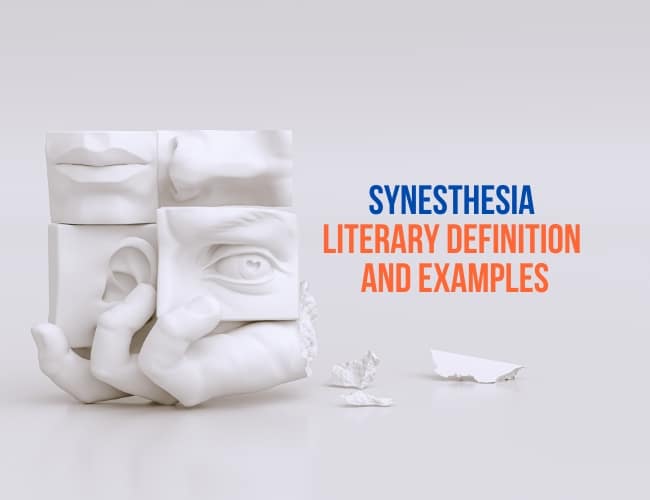Synesthesia describes a specific sensory experience, whether lived or literary. Today we'll explore the synesthesia literary definition and examples to help you understand this fascinating sensory phenomenon.

Heard any of these phrases before?
“Taste the rainbow.”
“You've never seen a taste like this.”
“Life tastes good.”
What do the above sentences have in common besides being advertising slogans for multinational companies?
They are examples of synesthesia.
“What's synesthesia?” I hear you cry.
Glad you asked.
Synesthesia is the stimulation or evocation of one sense from a stimulus associated with a different sense. Let's take a look.
Synesthesia Literary Definition
Synesthesia occurs in real life and in literature. People with synesthesia perceive one sense stimulus through a different sense.
For example, the musical note C might be red, and the written word “clever” might smell like chocolate. In the first instance, sound is experienced as sight, and the second example transposes the sense of sight into taste. It's a different kind of sensory experience.
In literature, synesthesia is a rhetorical device that describes or associates one sense in terms of another, often in the form of a simile or other figure of speech. It involves intertwining or connecting sensations of touch, taste, sight, hearing, and smell to create rich, multi-layered descriptions.
Phrases like “bright idea,” “cool dress,” “the idea stinks,” and “bitter cold” apply sensory words to items that don't fit the category.
An idea has no substance, so it can't possibly be bright. When we call a dress cool, we are generally not speaking of the temperature of the material. Just as an idea has no luminosity, neither does it have an odor. Cold does not have taste (though cold substances might).
The word comes to us from Greek syn, “together” + aisthēsis, “feeling, sense” and was coined in the late 1800s. Thus, synesthesia is a “feeling together” of the senses. Or as Webster puts it, “a concomitant sensation; especially : a subjective sensation or image of a sense (as of color) other than the one (as of sound) being stimulated.” There really are people who smell color, hear texture, see sound, and more.
When writers use the technique of synesthesia as a literary device, they are taking these everyday associations and applying them to a text with the purpose of making the description more memorable and accessible for readers. In literature, synesthesia is the technique of presenting ideas, characters, places, etc. in a way that appeals to more than one sense at a time.
Synesthesia Examples in Literature
Literature is rife with instances of synesthesia. Perhaps the most famous example—or, at least, the example most often cited by articles on synesthesia in literature—comes from “Inferno” in Dante's Divine Comedy. Hell is “the regions where the sun is silent.” The imagery, substituting sound for sight, evokes a sense of despair.
Dante isn't the only author to use synesthesia.
In Exodus 10:21, God tells Moses, “Stretch out your hand toward heaven, that there may be darkness over the land of Egypt, a darkness to be felt.” Sight becomes touch.
Revelation 5:8 presents the following scene: “And when he had taken the scroll, the four living creatures and the twenty-four elders fell down before the Lamb, each holding a harp, and golden bowls full of incense, which are the prayers of the saints.” Sound transforms to smell.
The Song of Solomon gives us this protestation of love: “How beautiful is your love, my sister, my bride! How much better is your love than wine, and the fragrance of your oils than any spice! Your lips drip nectar, my bride; honey and milk are under your tongue; the fragrance of your garments is like the fragrance of Lebanon.” (Song 4:10–11) Love, an idea, is expressed through the sense of taste and the sense of smell.
Keeping with the theme of love and biblically related settings, Oscar Wilde provides us with an example of synesthesia in his play Salome. “In the whole world there was nothing so red as thy mouth. Thy voice was a censer that scattered strange perfumes, and when I looked on thee I heard a strange music. Ah! wherefore didst thou not look at me, Jokanaan?”
The synesthesia is subtle, but Salome replaces sound (thy voice) with smell (censer that scattered strange perfumes) and sight (I looked on thee) with sound (I heard a strange music).
As noted above, literature is replete with instances of synesthesia. Keats, Shakespeare, Dickinson, and Frost are merely four that many writers adduce.
Vladimir Nabokov, the celebrated author of Lolita, was interviewed by the BBC in 1962, and said this about his synesthesia: The long “a” of the English alphabet has for me the tint of weathered wood, but a French “a” evokes polished ebony.
Synesthesia is not just a literary technique, however. We also have synesthesia in movies. An example of combining taste and sight is Ratatouille's “Flavor Scene.” Sound and sight correlate in the Fugue section of Johann Sebastian Bach's “Toccata and Fugue in d” in Disney's Fantasia (1940).
Why Do Writers Use Synesthesia?
So, why do writers use synesthesia, and why should you?
Synesthesia can lend a deeper meaning to your words, and it can connect your reader to your prose in a way that is creative and unique. The more senses we writers employ, the more memorable the experience for the reader. Using synesthesia adds layers of meaning, connotations, and pleasure to your text.
Add depth and richness to your writing by mixing the senses through synesthesia to produce vivid, thought-provoking, and memorable experiences for your readers. Learn from great writers of the past.
Want to learn about other tools you can use in your writing? Check out our post on pyrrhic victories here!
Where have you noticed synesthesia? Share in the comments.
PRACTICE
Spend fifteen minutes writing a scene in which you use synesthesia to add new sensory layers in your description.
Or do a search and find examples from your favorite author(s) of synesthesia.
Post your practice in the Pro Practice Workshop and leave feedback for a few other writers too!

Robert Harrell
Robert Harrell is a grammar nerd—and a language teacher, medieval re-creationist, musician, traveler, and theologian. His interests inform his stories and coaching. Published in German, Spanish, and French, with two English-language YA/NA series underway, Robert is pursuing The Write Practice Book Coach Certification to help other writers excel. Learn more at his website.
0 Comments